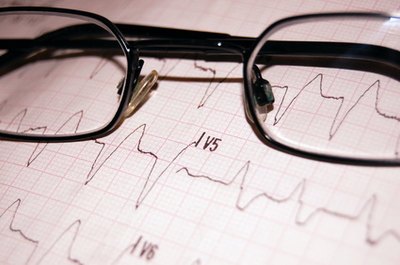
Heart rate changes based on the position of your body. According to the American Heart Association, or AHA, your resting heart rate is the number of times your heart beats per minute when you are at rest. In most cases, your resting heart rate will be around 60 to 100 beats per minute. Your heart rate depends on numerous factors, including air temperature, altitude, fitness level and hydration status. The position of your body -- sitting, standing or lying down -- also influences how quickly your heart beats each minute.
Anatomy
The heart is one of your body's most important organs. According to the Kids Health website, your heart is a shell-shaped muscle and organ that pumps blood through your arteries to your tissues and organs. Your heart beats or contracts when it is filled with blood. The movement of blood through your heart and around your body is known as circulation. The Kids Health website states that it takes less than 60 seconds for your heart to pump blood to all of your body's cells. Your heart beats constantly from before birth until the moment you die.
Heart Rate
Your heart rate is the number of times your heart beats in one minute. According to MayoClinic.com, the normal resting heart rate for adults varies considerably from person to person. Certain medical conditions, certain medications and cardiovascular fitness status can all affect your resting and sub-maximal heart rate. Sub-maximal heart rate is the number of times your heart beats each minute when you are exercising at an exercise intensity that is less than your maximum effort. MayoClinic.com states that, for healthy adults, a lower resting heart rate usually implies more efficient heart function and better cardiovascular fitness.
Positions
Your body position can influence the number of times your heart beats per minute. When you are lying down -- and especially when you are lying in a declined position -- your heart beats fewer times per minute than when you are sitting or standing. When you are lying down, the effect of gravity on your body is reduced, allowing more blood to flow back to your heart through your veins. Because more blood returns to the heart, the body is able to pump more blood per beat, which means that less beats per minute are required to satisfy your body's demand for blood, oxygen and nutrients. If you move from a lying or sitting position to a standing position, you may experience a sudden increase in heart rate.
Complications
Because you change body positions many times each day, it's important to understand the possible heart-related complications associated with moving from one position to another. In some individuals, especially the elderly, quickly changing positions -- e.g. moving from a lying position to a standing position -- can cause you to become light-headed or faint. With quick movements such as this, the heart is unable to pump a sufficient amount of blood to the brain, causing you to pass out. When you pass out, you usually end up lying on the floor, which is an advantageous position for your heart, as the effects of gravity are reduced and more blood can be pumped to your brain.
Considerations
You can measure the changes in your heart rate between lying down, sitting and standing positions by using a heart-rate monitor. According to the Polar U.S.A. website, a heart rate monitor provides instant, real-time feedback about how your heart is responding to various challenges and provocations. Recording your resting heart rate while lying in bed each morning is a simple and effective way to track your fitness progress or monitor your health. Most individuals experiencing an illness or who have trained too much will have an elevated -- above baseline values -- resting heart rate in the morning. Knowing your resting heart rate can help dictate your day's activities.
www.livestrong.com





No comments:
Post a Comment